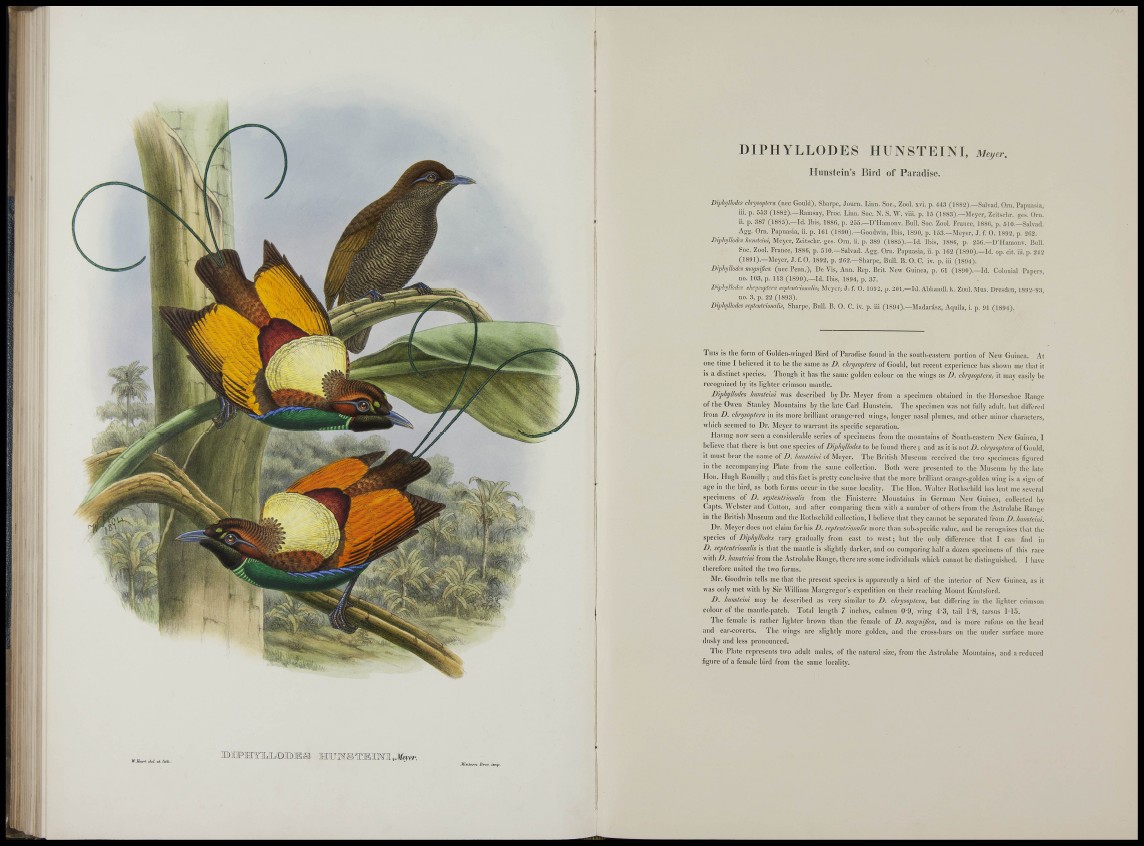
Ifij-;
^.Snrl del ft lUh .
. Vinierro Sros. ¿in
DIPHYLLODES HUNSTEINI, Mcjer.
Hunstein's Bird of Paradise.
Diphjlhies cJinjsoptm (nec Gould), Shai pe, Jouin. Linn. Soc., Zool. xvi. p. 443 (1882),—Salvad. Orn. Papuasia,
iii. p. 553 (1882).—Ramsay, Proc. Linn. Soc. N. S. W. "viii. p. 15 (1883).—Meyer, Zeitsclir. gcs. Or\i.
ii. p. 387 (1885).—Id. Ibis, 1880, p. 253.—D'llamonv. Bull. Soc. Zool. France, 188IÍ, p. 510.—Salvad.
Agg. Orn. Papuasia, ii. p. Kil (1890).—Goodwin, Ibis, 18U0, p. 153.—Meyer, .1. f. O. 1892, p. 202.
DiphjlMes Imnsteini, Meyer, Zeitschr. ges. Orn. ii. p. 389 (1885).—Id. Ibis, 1880, p. 250.—D'Hainonv. Bull.
Soc. Zool. France, 1880, p. 510.—Salvad. Agg. Orn. Papuasia, ii. p. 102 (1890).—Id. op. cit. iii. p. 242
(1891).—Meyer, .1. f. 0 . 1892, p. 202.—Sharpe, Bull. B. O. C. iv. p. iii (1894).
Diphjlloda magnifica (nec Penn.), De Vis, Ann. Rep. Bi-it. New Guinea, p. CI (1890).—Id. Colonial Papers,
no. 103, p. 113 (1890).—Id. Ibis, 1894, p. 37.
DipJnjUodes chnjsoptera septentrknalis, Meyer, J. f. O. 1892, p. 201.—Id. Abhandl. k. Zool. Mus. Dresden, 1892-93,
no. 3, p. 22 (1893).
Diphjlhdes spptentrionalis, Sharpe, Bull. B. 0. C. iv. p. iii (1894).—Madarász, Aquila, i. p. 91 (1894).
THIS is the form of Goklen-winged Bird of Paradise found in tlie south-eastern portion of New Guinea. At
one time I believed it to be the same as D. chysoplem of Gould, but recent experience has shown me that it
is a distinct species. Though it has the same golden colour on the wings as D. chnjsoptera, it may easily he
recognized by its lighter crimson mantle.
Diphylloiles hunsiemi was described by Dr. Meyer from a specimen obtained in the Horseshoe Range
of the Owen Stanley Mountains by the late Carl Hunstein. The specimen was not fully adult, but differed
from D. chnjsoptera in its more brilliant orange-red wing.s, longer nasal ])lumc.s, and otber minor characters,
which seemed to Dr. Meyer to warrant its specific sejiaration.
Having now seen a considerable series of sj)ecimens from the mountains of Soiitli-eastin-n New Guinea, I
believe that there is but one species of DiphjUodes to be found there ; and as it is not D. chrymptera of Gould,
it must bear the name of D. humteim of Meyer. The British Museum received the two specimens figured
in the accom|)anylng Plate from the same collection. Both were presented to the Museum by the late
Hon. Hugh Koinllly; and this fact Is pretty conclusive that the more brilliant orange-golden wing is a sign of
age in the bird, as both forms occur in the same locality. The Hon. Walter Rothschild has lent me several
specimens of D. septentiionalis from the Finlsterre Mountains in Geruian New Guhiea, collected by
Capts. Webster and Cotton, and after comparing them with a number of others from the Astrolabe Range
in the British Museum and the Rothschild collection, I believe that they cannot be separated from D. humteini.
Dr. Meyer does not claim for his D. septentriomdh more than sub-specific value, and be recognizes that the
species of DiphjUocks vary gradually from east to west; hut the only difference that I can find in
D. sepientrhnalis is that the mantle is slightly darker, and on com])arlng half a dozen specimens of this race
with D. Imnstemi from the Astrolabe Range, there are some individuals which cannot be distinguished. I bave
therefore united the two forms.
Rlr. Goodwin tells me that the present speclcs is apparently a bird of the interior of New Guinea, as it
was only met wltb by Sir M'llllau] Macgregor' s expedition on their reaching Mount Knutsford.
D. kmtemi may be described as very similar to D. clmjsoptera, but dlfferli]g in the lighter crimson
colour of the mantle-patch. Total lengtli 7 Inches, culmen O'O, wing 4-3, tail 1-8, tarsus Mo.
The female is rather lighter brown than tbe female of D. magmfiai, and is more rufous on the head
atul ear-coverts. The wings are slightly more golden, and the cross-bars on the under surface more
dusky and less ])ronounced.
The Plate represents two adult males, of the natural size, from the Astrolabe Mountains, and a reduced
figure of a female bird from tbe same locality.
I^il! «1